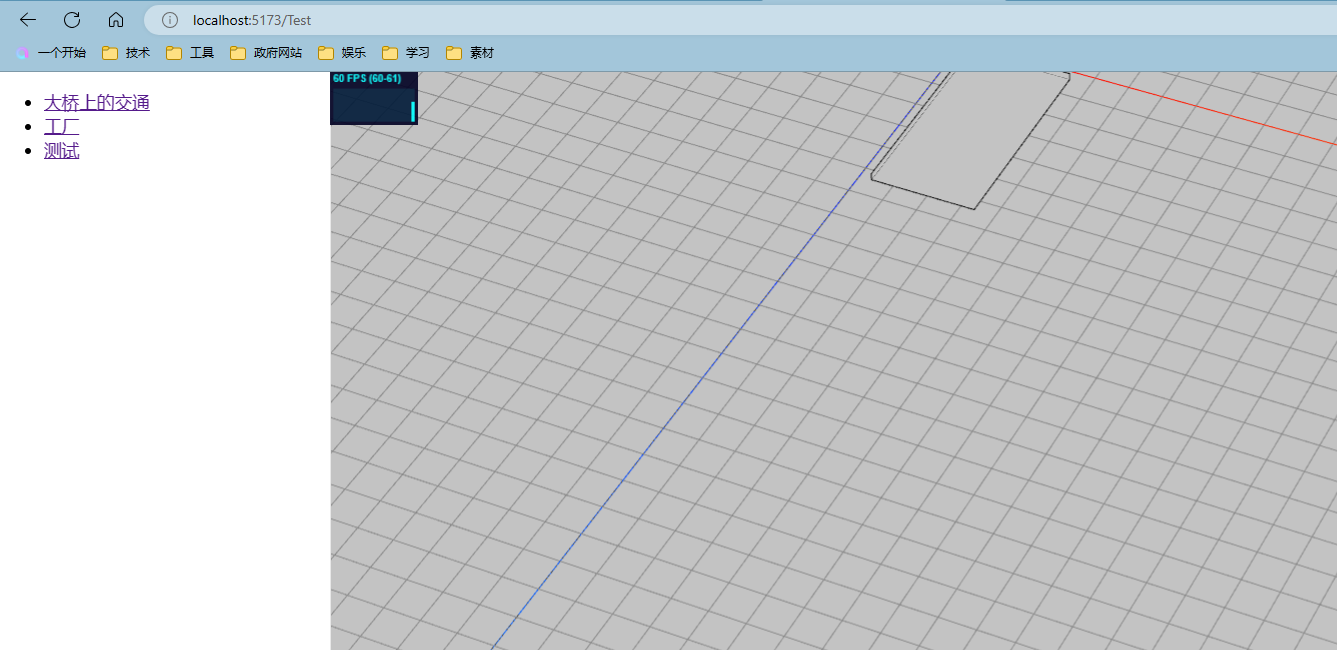3D技术是前端技术中,比较高端的技术,所以能用的工具还比较少,相信以后3D技术的应用会越来越多。
Threejs就是一个很好的3D框架,Threejs不但是开源免费的框架,文档也特别的给力。
关于Threejs的详细,可以访问three.js的官网。
Three.js – JavaScript 3D Library ()
Vue是现在前端的三个框架之一,我也是我最常使用的MVVM框架。
Typescript是对Javascript这种弱类型语言的扩展,可以用强语言的方式来写Javascript,兼容ES 2017。
本文用Vue3+Typescript对Threejs进行了以下整合。
一、搭建Vue3+Typescript的基础框架
工欲善其事,必先利其器。
我们首先要用Vite搭建一下脚手架。
在Dos命令中使用
pnpm create vite threejs-vue3-ts --template vue执行命令后,当前文件夹增加了threejs-vue3-ts的文件夹。
里面有vue3+typescript所需要的所有基础代码
二、设置Vue的路由
这里我写了三个threejs的demo, 所以配置了三个路由,代码如下:
import { createRouter, createWebHistory, RouteRecordRaw } from 'vue-router'
const history = createWebHistory()
const routes: Array<RouteRecordRaw> = [
{
path: '/',
redirect: 'bridgeTraffic'
},
{
path: '/bridgeTraffic',
name: 'bridgeTraffic',
component: () => import('../views/BridgeTraffic.vue')
},
{
path: '/car',
name: 'car',
component: () => import('../views/Car.vue')
},
{
path: '/earthAndMoon',
name: 'earthAndMoon',
component: () => import('../views/EarthAndMoon.vue')
}
]
const router = createRouter({
history,
routes
})
export default router有了Vue的路由后,你就可以通过切换路由切换不同的页面了。
三、具体的代码实现。
1)安装three.js
通过npm安装:
npm i three2)编写App.vue
这里,我们把页面分成两块,一块用来显示导航,一块用来显示3D的场景。
代码:
<template>
<div class="container">
<div class="nav">
<ul>
<li>
<a href>大桥上的交通</a>
</li>
<li>
<a href>工厂</a>
</li>
<li>
<a href>测试</a>
</li>
</ul>
</div>
<div class="content">
<router-view></router-view>
</div>
</div>
</template>
<script setup lang="ts">
</script>
<style scoped>
.container{
height: 100%;
}
.nav {
position: fixed;
z-index: 100;
left: 0px;
width: 300px;;
height: 100%;
overflow: auto;
border-right: 1px solid #E8E8E8;
display: flex;
flex-direction: column;
transition: 0s 0s height;
}
.content {
position: absolute;
border: 0px;
left: 0;
right: 0;
width: 100%;
height: 100%;
overflow: auto;
padding-left: 300px;
}
</style>右边route-view用来显示Component。
接下来,我们再增加一个vue文件,作为显示的Compoent,这里我们暂时取名Test.vue。
Test.vue
<template>
<div ref="container" class="container"></div>
</template>
<script setup lang="ts">
import { onMounted, onUnmounted, getCurrentInstance } from 'vue'
import { TestScene } from '../scene/TestScene'
let scene:TestScene|null = null;
onMounted(() => {
const container = getCurrentInstance()?.refs['container'];
// 场景的容器
scene = new TestScene();
scene.init(container);
})
onUnmounted(() => {
if (scene) {
scene.clear();
}
});
</script>
<style scoped>
.container {
width: 100%;
height: 100%;
overflow: hidden;
position: relative;
}
</style>在建一个TestScene.ts。来处理场景的相关逻辑就差不多了。
import * as THREE from 'three';
import FPSState from '../plugins/FPSState';
import { OrbitControls } from 'three/examples/jsm/controls/OrbitControls';
import {Thing} from './thing'
import {TreeSideBoxGeometry} from './TreeSideBoxGeometry';
import data from './data.json'
export class TestScene {
parameters:any = null;
container: HTMLElement | null = null;
stats: any;
camera: THREE.PerspectiveCamera | null = null;
scene: THREE.Scene | null = null;
renderer: THREE.WebGLRenderer | null = null;
onWindowResize: any;
onWindowMousedown: any;
things: Array<Thing> = [];
constructor() {
}
/**
* 创建渲染器
*/
createRenderer() {
// 渲染器
const renderer = this.renderer = new THREE.WebGLRenderer({ antialias: true, logarithmicDepthBuffer: true });
renderer.setClearColor('white');
renderer.setPixelRatio(window.devicePixelRatio);
renderer.setSize(this.container.offsetWidth, this.container.offsetHeight);
renderer.toneMapping = THREE.ACESFilmicToneMapping;
renderer.shadowMap.enabled = true;
renderer.shadowMap.type = THREE.VSMShadowMap;
this.container.appendChild(renderer.domElement);
}
/**
* 创建摄像机
*/
createCamera() {
// 相机
let camera = this.camera = new THREE.PerspectiveCamera(15, this.container.offsetWidth / this.container.offsetHeight, 1, 20000);
camera.position.set(1800, 3000, 3500);
// 相机轨道控制器
let controls: OrbitControls = new OrbitControls(camera, this.renderer.domElement);
controls.maxPolarAngle = Math.PI * 0.495;
// controls.enablePan = false
controls.target.set(600, 10, 800);
controls.maxDistance = 8000.0;
controls.update();
}
/**
* 创建性能监视器
*/
createFPSState() {
// 性能监视器
const stats = this.stats = new FPSState();
stats.appendTo(this.container);
}
init(el:any) {
this.container = el;
this.createRenderer();
this.createCamera();
this.createFPSState();
// 场景
const scene = this.scene = new THREE.Scene();
const gridHelper = new THREE.GridHelper( 3000, 60 );
scene.add( gridHelper );
scene.add( new THREE.AxesHelper( 2000 ) );
console.log('data', data);
const geometry = new THREE.PlaneGeometry( 10000, 10000 );
geometry.rotateX( - Math.PI / 2 );
let plane = new THREE.Mesh( geometry, new THREE.MeshBasicMaterial( { color: 0xffffff,side: THREE.DoubleSide } ) );
plane.position.set(0, -1, 0);
scene.add( plane );
let x = 30;
let y = 40;
let width = 150;
let height = 300;
this.createArea(x, y, width, height);
// 开启渲染
this.animate();
let that = this;
const onWindowResize = this.onWindowResize = function() {
if (that.container) {
camera.aspect = that.container?.offsetWidth / that.container?.offsetHeight;
camera.updateProjectionMatrix();
that.renderer?.setSize(that.container.offsetWidth, that.container.offsetHeight);
}
}
window.addEventListener('resize', onWindowResize);
const onWindowMousedown = this.onWindowMousedown = function(event:any) {
const raycaster = new THREE.Raycaster();
const pointer = new THREE.Vector2();
pointer.x = (event.clientX / window.innerWidth) * 2 - 1;
pointer.y = - (event.clientY / window.innerHeight) * 2 + 1;
raycaster.setFromCamera(pointer, camera)
}
window.addEventListener('mousedown', onWindowMousedown);
}
/**
* 创建几何形状
*/
createArea(x: number, y: number, width: number, height: number) {
let scene = this.scene;
const rollOverGeo = new TreeSideBoxGeometry(width, 10, height);
const coneEdges = new THREE.EdgesGeometry( rollOverGeo);
var edgesMtl = new THREE.LineBasicMaterial({color: 0x000000});
let rollOverMaterial = new THREE.MeshBasicMaterial( { color: 0xffffff,side: THREE.DoubleSide } );
let rollOverMesh = new THREE.Mesh( rollOverGeo, rollOverMaterial );
const boundingBox = new THREE.LineSegments(coneEdges, edgesMtl);
x = x + width / 2;
y = y + height / 2;
boundingBox.position.set(x, 25, y);
scene?.add(boundingBox);
rollOverMesh.position.set(x, 25, y);
scene?.add( rollOverMesh );
}
addThing(thing: Thing) {
this.things.push(thing);
}
animate() {
requestAnimationFrame(()=> {
this.animate();
});
this.render();
this.stats.update();
}
render() {
if (this.camera && this.scene && this.renderer) {
this.renderer.render(this.scene, this.camera);
}
}
clear() {
if (this.onWindowResize) {
window.removeEventListener('resize', this.onWindowResize)
}
if (this.onWindowMousedown) {
window.removeEventListener('mousedown', this.onWindowMousedown);
}
if (this.scene) {
this.scene.traverse((child: any) => {
if (child.isMesh) {
if (child.geometry) child.geometry.dispose();
if (child.material) child.material.dispose();
child.clear();
}
});
}
}
}CommonScene里面分装了场景所需要的代码。
最后显示的效果:


